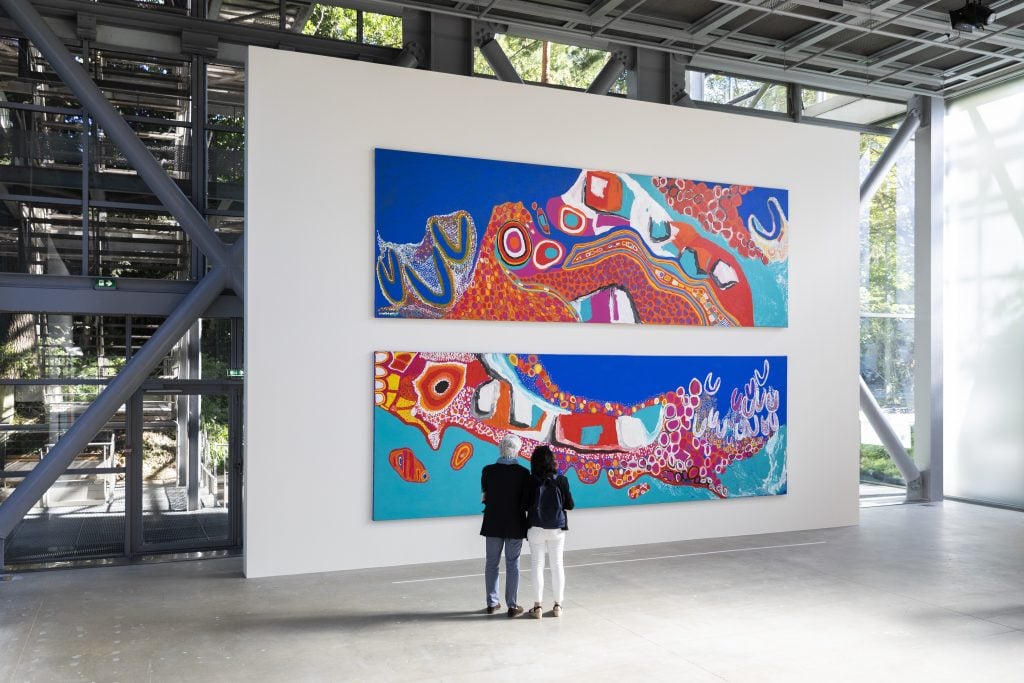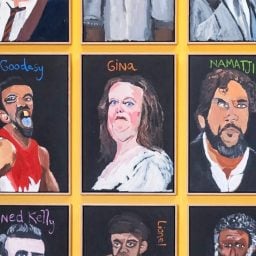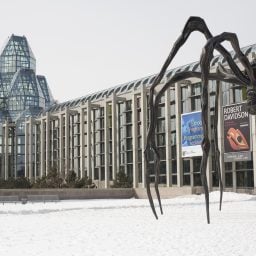Stretching across the walls of the Fondation Cartier in Paris are Sally Gabori’s vibrant paintings depicting her memories of the landscapes of Bentinck Island, off the northern coast of Australia. The first international exhibition on the late Aboriginal artist, it showcases her wide-ranging canvases executed in thick, dynamic brushstrokes. In shifting reds, pinks, blues, yellows, white, and black, the topographical works, while being abstract in appearance, portray the variations of light on the land and rivers.
Gabori is one of several Indigenous Australian artists being honored as Australia seeks to better support Aboriginal artists and culture. At the same time, global demand for their work has grown in recent years—along with forgeries. Here is who (and what) you need to know to navigate this expansive market.
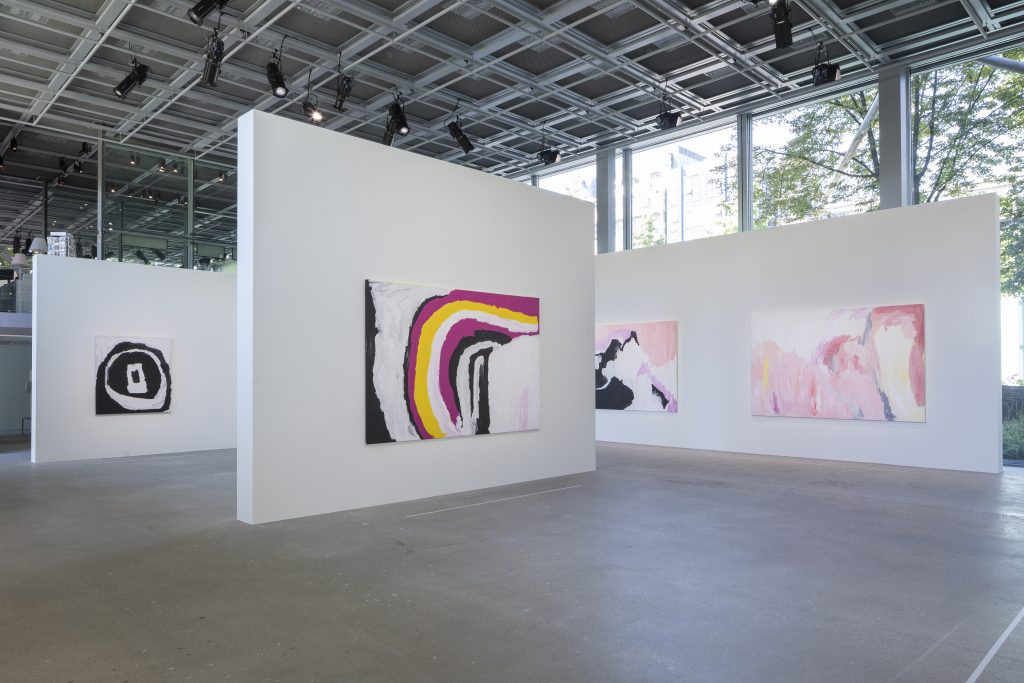
Installation view of the Mirdidingkingathi Juwarnda Sally Gabori exhibition. Fondation Cartier pour l’art contemporain, Paris. Photo by Thibaut Voisin
Artists to Know
Born in around 1924 as Mirdidingkingathi Juwarnda, Gabori is one of Australia’s best-known Aboriginal artists. Growing attention for the artist is reflected through the nation’s prime minister Anthony Albanese’s decision to attend the inauguration of Gabori’s exhibition at Fondation Cartier in Paris this July. Gabori and her family were among the last 63 surviving Kaiadilt residents to be evacuated and permanently exiled from their island to a Presbyterian mission on nearby Mornington Island in 1948, following a cyclone and tidal wave; the mission separated the Kaiadilt children from their parents.
When she was about 80, Gabori visited the Mornington Art Centre that had been later established there—the revelatory experience unleashed her desire to start painting. She painted over 2,000 canvases in the space of just nine years until her death in 2015, conveying her ancestral relationship to the land.
Elsewhere, other key figures are rapidly gaining more visibility, including Emily Kame Kngwarreye (1910-1996), whose mesmerizing paintings were included at the 2015 Venice Biennale’s main exhibition, “All The World’s Futures” curated by Okwui Enwezor. Gagosian in Paris had a solo show of her work earlier this year.
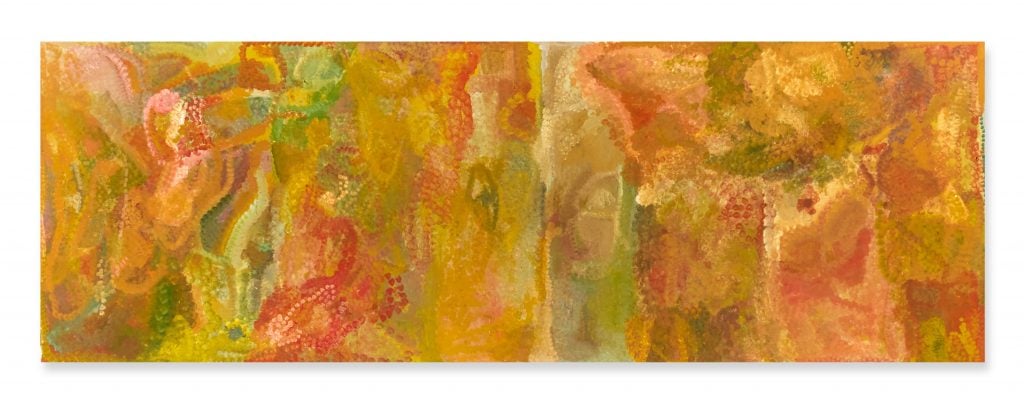
Emily Kame Kngwarreye, Merne Everything V (1993). Courtesy Sotheby’s
Interest in Aboriginal art is reflected through auction prices, too. At Sotheby’s sale of Aboriginal art in New York this May, Kngwarreye’s Alhalkere—Old Man Emu with Babies (1989), a shimmering, pointillist painting in reds, oranges and browns, sold for $819,000 (against an estimate of between $500,000 and $800,000). This is believed to be the second-highest result for a work by Kngwarreye, whose painting Earth Creation I (1994), was purchased by Australian art dealer Tim Olsen for AUS$2.1 million ($1.4 million) from Cooee Art auctions in Sydney in 2017. (The record for an Aboriginal artwork is Clifford Possum Tjapaltjarri’s epic painting Warlugulong (1977), which was bought by the National Gallery of Australia at Sotheby’s in Melbourne for AUS$2.4 million ($1.6 million) in 2007.)
“Emily Kame Kngwarreye was a superstar in her lifetime and the most famous, well-known artist in Australia,” Tim Klingender, Sotheby’s senior consultant of Australian art who founded the auction house’s Aboriginal art department in 1996, told Artnet News. “She had a relish for experimenting with painting, brushstrokes, and color, and produced many large-scale works.”
Besides the aforementioned artists, Francesca Cavazzini, Aboriginal art specialist at Bonhams Sydney, cites Lin Onus, John Mawurndjul, and Warlimpirrnga Tjapaltjarri among Australia’s established Aboriginal artists. Onus (1948-1996), had Aboriginal and Scottish heritage, and made paintings of nature that fused Aboriginal and western influences.
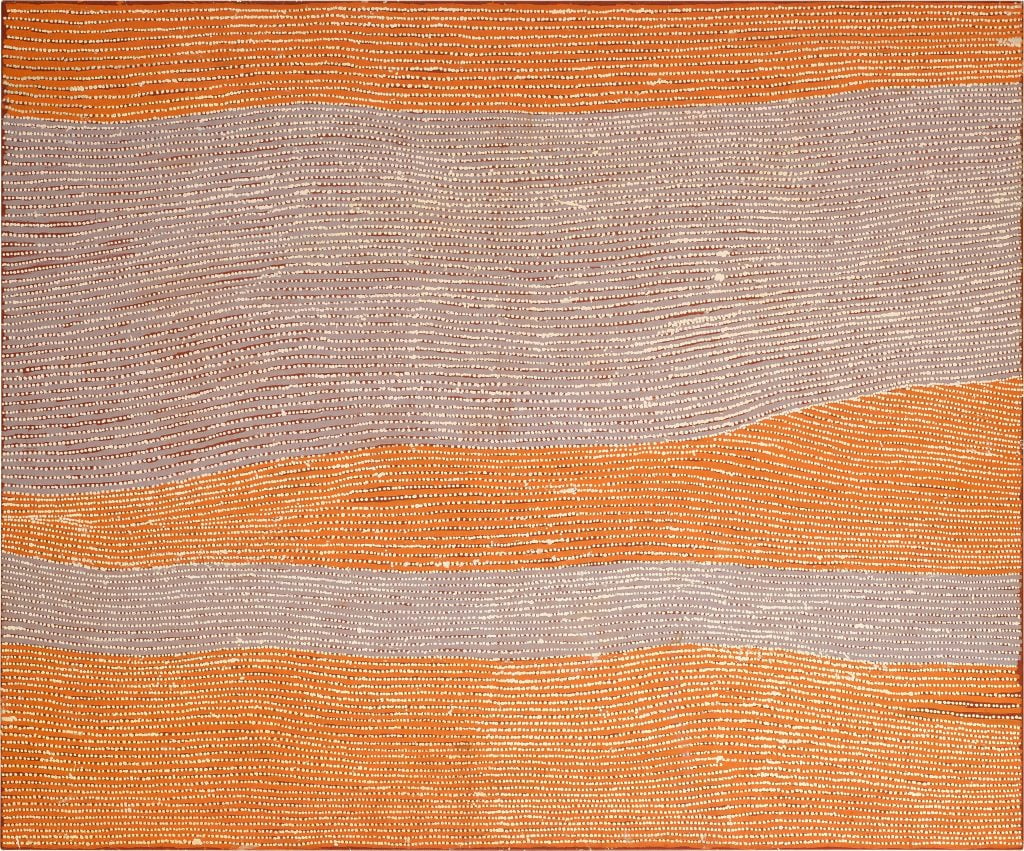
Willy Tjungurrayi Kaakuratintja Courtesy Sotheby’s
Mawurndjul, who is around 70, specializes in bark paintings and sculptures characterized by fine-painted cross-hatching. Tjapaltjarri, meanwhile, who is represented by Salon 94 in New York, makes optically hypnotic paintings with oscillating lines of countless dots that are inspired by undulating landscapes.
Among other artists to watch are Nonggirrnga Marawili, whose joyful, striking paintings are the subject of a solo exhibition, “Ganydjarr—Energy,” at Alcaston Gallery in Melbourne (through August 26). And huge diversity of work by dozens of emerging artists, meanwhile, can be discovered at the fourth National Indigenous Art Triennial, ‘Ceremony’, at the University of Queensland Art Museum (August 27 through November 26).
How to Spot Fakes (And Support Artists)
Provenance and ethically sourcing works is extremely important, said Klingender, especially as some Aboriginal artists have been exploited by unscrupulous dealers. There have been issues with inauthentic works circulating the market.
“There are around 100 art centers in Australia that are owned by Indigenous people and that have non-Indigenous managers, and Sotheby’s has never accepted works that have not originated from one of these art centers,” Klingender added. (Here is a list of government-approved Aboriginal art centers in the Northern Territory, where many Aboriginal artists live and work).
He said that painting was “the most major source of income for Indigenous people in remote communities in Australia” and that it enabled them “to nurture their culture and make a political stance” about colonialism.
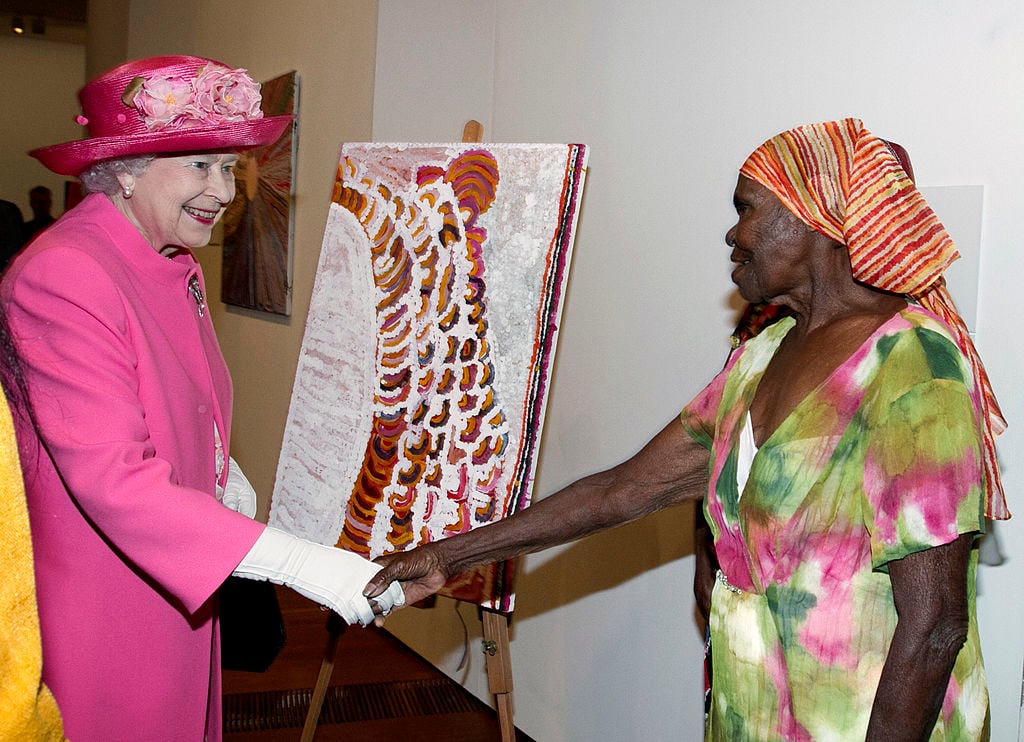
Queen Elizabeth 2 meets Aboriginal artist Muntararr Rosie Williams at the Ian Potter Centre in 2011 in Melbourne, Australia. Photo: Luis Ascui-Pool/Getty Images.
Bonhams includes Aboriginal art in its Australian art sales in Sydney, recognizing Aboriginal art as part of Australian art generally rather than as a standalone category. Indeed, the sale yesterday, August 23, of important Australian art featured paintings by leading Aboriginal artists alongside historical and modern works. Among the highlights was a painting by the acclaimed Indigenous artist Rover Thomas, whose landscape Rover’s Country (hills, creeks and rock hole) (1990) flew past its estimate to fetch AU$202,950 ($141,000). (Thomas didn’t work for one art center and mostly painted for the art dealer Mary Macha; this provenance should be listed on the back of his paintings.)
To support artists properly and make sure one is buying genuine work, Cavazzini, Aboriginal art specialist at Bonhams Sydney, also referred to the invaluable role of art centers. “If an artist’s work has come from an art center, there should typically be a catalog number on the back and a certificate,” Cavazzini noted.
Cavazzini conceded that some well-known artists would, at the request of non-Indigenous dealers, be photographed holding other artists’ works or would provide signatures to works that were not their own, leading to fakes appearing on the market.
“Sometimes you see auction houses offering hundreds of Aboriginal works, which they claim to be authentic, and photos of the artist painting the work. But sometimes it’s an artwork that someone else has painted,” she said. “It’s probably happening less than before but, unfortunately, it does still happen.”
Cavazzini also recounted that some non-Indigenous dealers have hugely exploited Aboriginal artists—a primary reason why seeking provenance is crucial. “Sometimes, they’ve kept an artist in a room and asked them to paint hundreds of paintings; the dealers are making a huge profit while the artist is getting very little and the quality of work is really low. On the positive side, there are more and more museum-quality exhibitions in Europe, the U.S. and Asia, so global buyers are being exposed to the very best and are becoming knowledgeable about what to collect.”
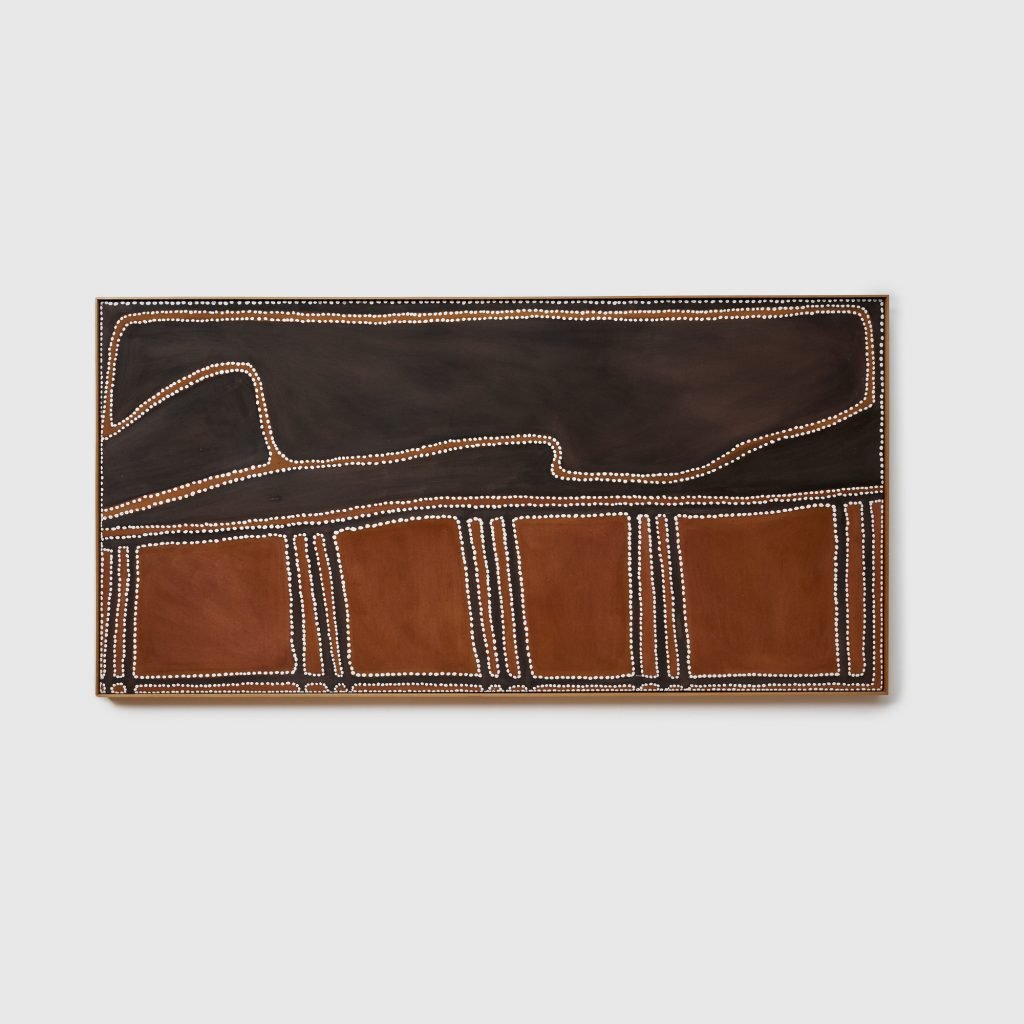
Rover Thomas Country (hills, creeks and rock hole) (1990). Courtesy Bonhams sale of Important Australian Art.
Make Sure to Have the Right Paperwork
Collectors buying works from Australia should be aware, however, that they need to apply for an export permit. The Australian newspaper The Age reported in 2008 how the New York-based collectors John and Barbara Wilkerson were denied an export permit after purchasing Tommy Lowry Tjapaltjarri’s painting Two Men Dreaming at Kuluntjarranya (1984) at Sotheby’s for $576,000 (US$445,832) in 2007.
According to the report, the government amended the Protection of Movable Cultural Heritage Act to keep valuable national heritage objects, including Aboriginal paintings produced within the Indigenous community of Papunya during the early 1970s, in Australia. Every Aboriginal artwork that is at least 20 years or older and which has a value of more than AUS$10,000 ($6,924) needs official export clearance.
The Wilkersons were granted a series of temporary export permits so they could include the painting in the touring exhibition, “Icons of the Desert: Early Aboriginal Paintings from Papunya,” in the U.S., but they were ultimately unable to permanently export the work. The duo offered it for sale for AUS$2 million ($1.5 million) through D’Lan Contemporary gallery in Melbourne last year.
